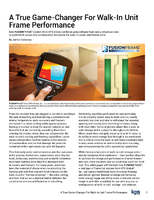ASTM Develops Standard for low-speed vehicle barriers.
Press Release Summary:
ASTM WK13074, Test Method for Low Speed Barriers for Errant Vehicles, aims to minimize damage caused by automobile crashes at storefront or other pedestrian areas. Standard will specifically cover bollards, barriers, gates, planters, and other products, used in instances not already covered by high-security K-rated bollards, designed to provide simple security, pedestrian protection, or denial of access to vehicles less than 4,500 lb at traffic speeds of 30 mph and under.
Original Press Release:
ASTM Security Systems Committee Developing Proposed Standard for Low Speed Vehicle Barriers
W. CONSHOHOCKEN, Pa.-It happens all too often: a driver suddenly loses control of a car, sending it into a storefront or other pedestrian area. Property damage and serious injuries, sometimes fatal, can result from these accidents.
In an effort to minimize the damage caused by such crashes, ASTM International Committee F12 on Security Systems and Equipment is developing a proposed new standard, ASTM WK13074, Test Method for Low Speed Barriers for Errant Vehicles. The standard is under the jurisdiction of Subcommittee F12.10 on Systems Products and Services.
"Separating pedestrians from traffic and protecting storefronts from the impacts of cars that jump curbs as a result of operator error are compelling issues of public safety and building and public space design," says Robert Reiter, a member of Subcommittee F12.10, and a storefront safety consultant. The proposed new standard will begin to address this issue by providing testing parameters for lower speed vehicle barriers.
ASTM WK13074 will cover the bollards, barriers, gates, planters and other products used in the many instances not covered by high security K-rated bollards, which are designed to keep vehicles from intentionally coming through a security perimeter. "ASTM WK13074 will provide architects and engineers with tools to evaluate products and materials that will be put in place to provide simple security, pedestrian protection or denial of access to vehicles less than 4,500 pounds at traffic speeds of 30 miles per hour and under," confirms Dean Alberson, Ph.D., P.E., subcommittee chairman and research engineer at the Texas Transportation Institute at Texas A&M University. Adds Reiter, "Research, statistics, and media reports confirm that such applications cover the majority of cases where vehicle/pedestrian injuries and property damage are occurring."
When approved, ASTM WK13074 will enable designers to properly size pedestrian protection devices based on lower energy threats such as passenger vehicles traveling at lower speeds. Manufacturers will have certified laboratories use the approved standard to obtain pedestrian ratings for their products. Currently, barriers such as these are not typically tested and their performance is largely unknown.
Reiter says that the prevailing standards for testing bollards and barriers are the K rating from the U.S. Department of State, and ASTM F2656, Test Method for Vehicle Crash Testing of Perimeter Barriers. Neither of these standards applies to most cases where bollards are used. "As opposed to K-rated bollards, most bollards are used for either simple access denial or pedestrian safety," Reiter says. "Most people don't live, work, shop or eat dinner at a high security facility."
The subcommittee is especially interested in working with stakeholders who want a testing protocol that will provide definitive guidance for testing products to be incorporated into public safety programs, site security specifications and property protection features. Alberson adds that the subcommittee is also interested in participation from governmental entities as well as manufacturers and end users who are interested in contributing to the development of ASTM WK13074.
ASTM International is one of the largest international standards development and delivery systems in the world. ASTM International meets the World Trade Organization (WTO) principles for the development of international standards: coherence, consensus, development dimension, effectiveness, impartiality, openness, relevance and transparency. ASTM standards are accepted and used in research and development, product testing, quality systems and commercial transactions.
For more news in this sector, visit www.astm.org/sn-safety or follow us on Twitter @ASTMSafety.
ASTM Committee F12 Next Meeting: Oct. 22-24, 2012, October Committee Week, Atlanta, Ga.
Technical Contacts: Rob Reiter, Storefront Safety Consultant, Phone: 909-964-2906; rob.reiter.pp@gmail.com; Dean Alberson, Texas Transportation Institute, Texas A&M University, Phone: 979-458-3874; d-alberson@tamu.edu
ASTM Staff Contact: Joseph Hugo, Phone: 610-832-9740; jhugo@astm.org
ASTM PR Contact: Barbara Schindler, Phone: 610-832-9603; bschindler@astm.org




